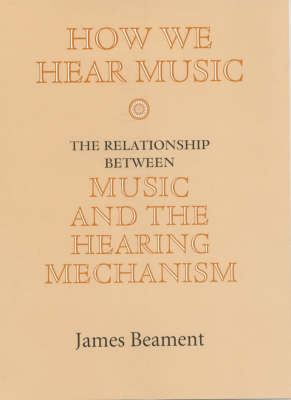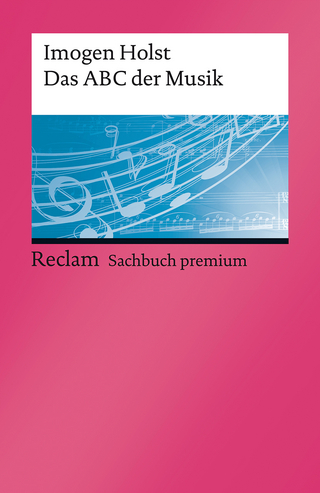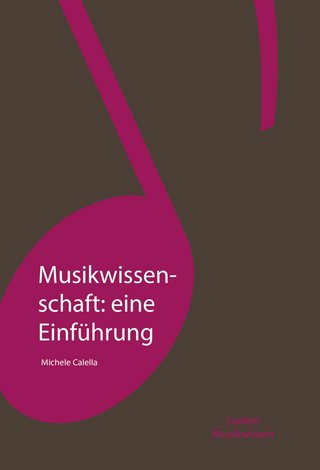
How We Hear Music
The Relationship between Music and the Hearing Mechanism
Seiten
2001
The Boydell Press (Verlag)
978-0-85115-813-6 (ISBN)
The Boydell Press (Verlag)
978-0-85115-813-6 (ISBN)
- Titel ist leider vergriffen;
keine Neuauflage - Artikel merken
An account of how musical sounds are coded by the ear, and the implications for the origin and evolution of music.
Choice Outstanding Academic Title (2002)Our hearing system chose the sounds for music. During the past fifty years there have been spectacular advances in our knowledge of how that system works and it seems possible thatit might provide explanations for a range of musical phenomena. This book begins by discussing the early evolution of simple 'western' tonal music; what exactly were the characteristics of the intervals and scales which hearing selected. It then considers problems such as what hearing has selected as instrumental tone, and why we have such a peculiar assessment of loudness; why is that independent of pitch, and why is hearing so sensitive to time? Does themechanism of hearing determine our pitch discrimination, which differs so much across our hearing range? Amongst other things, this discussion leads to the conclusion that the harmonics of musical sounds, which are the basis of so much theory about music, did not and cannot play the role which has been so widely attributed to them ever since the work of Helmholtz in 1870. There follows a simplified account of the hearing mechanism: how musical sound is coded by the ear, the nature of the processing stations through which the information passes before it creates sensation in the cortex, and the extent to which it provides answers to the questions which have been raised. This produces a rather different view of the basis of some fundamental features of music from those which are commonly held. It also leads to the conclusion that music started with primitive instruments rather than with the human voice. Finally, the biological reasons for the hearing mechanism behaving as it does are explained, and thus the reasons for the sensations of music being exper- ienced in the way they are. No scientific knowledge is assumed; any simple physical acoustics required is explained, and there are no mathematical equations.The late Professor Sir JAMES BEAMENT was a distinguished scientist and musician, who taught and examined music students at Cambridge University.
Choice Outstanding Academic Title (2002)Our hearing system chose the sounds for music. During the past fifty years there have been spectacular advances in our knowledge of how that system works and it seems possible thatit might provide explanations for a range of musical phenomena. This book begins by discussing the early evolution of simple 'western' tonal music; what exactly were the characteristics of the intervals and scales which hearing selected. It then considers problems such as what hearing has selected as instrumental tone, and why we have such a peculiar assessment of loudness; why is that independent of pitch, and why is hearing so sensitive to time? Does themechanism of hearing determine our pitch discrimination, which differs so much across our hearing range? Amongst other things, this discussion leads to the conclusion that the harmonics of musical sounds, which are the basis of so much theory about music, did not and cannot play the role which has been so widely attributed to them ever since the work of Helmholtz in 1870. There follows a simplified account of the hearing mechanism: how musical sound is coded by the ear, the nature of the processing stations through which the information passes before it creates sensation in the cortex, and the extent to which it provides answers to the questions which have been raised. This produces a rather different view of the basis of some fundamental features of music from those which are commonly held. It also leads to the conclusion that music started with primitive instruments rather than with the human voice. Finally, the biological reasons for the hearing mechanism behaving as it does are explained, and thus the reasons for the sensations of music being exper- ienced in the way they are. No scientific knowledge is assumed; any simple physical acoustics required is explained, and there are no mathematical equations.The late Professor Sir JAMES BEAMENT was a distinguished scientist and musician, who taught and examined music students at Cambridge University.
James Beament is a distinguished scientist and a musician who plays jazz and serious music and composes both kinds. He has had extensive experience in teaching and examining music students in Cambridge University.
Part 1 Preliminaries. Part 2 Aural archaeology. Part 3 Hearing selects intervals. Part 4 The beguiling harmonic theory. Part 5 The imitating voice. Part 6 Hearing simultaneous pitches. Part 7 Patterns in harmony. Part 8 Loudness: the basic dynamic scale. Part 9 Music through the hearing machine. Part 10 A sense of direction. Part 11 Time and rhythm. Part 12 Conclusions.
| Erscheint lt. Verlag | 20.11.2002 |
|---|---|
| Zusatzinfo | 26 line. |
| Verlagsort | Woodbridge |
| Sprache | englisch |
| Maße | 156 x 234 mm |
| Themenwelt | Kunst / Musik / Theater ► Musik ► Musiktheorie / Musiklehre |
| Medizin / Pharmazie ► Medizinische Fachgebiete ► HNO-Heilkunde | |
| ISBN-10 | 0-85115-813-7 / 0851158137 |
| ISBN-13 | 978-0-85115-813-6 / 9780851158136 |
| Zustand | Neuware |
| Haben Sie eine Frage zum Produkt? |
Mehr entdecken
aus dem Bereich
aus dem Bereich
Grundbegriffe, Harmonik, Formen, Instrumente
Buch | Softcover (2021)
Philipp Reclam (Verlag)
7,80 €
Jazz als Gegenkultur im westlichen Nachkriegsdeutschland
Buch | Hardcover (2024)
edition text + kritik (Verlag)
42,00 €


